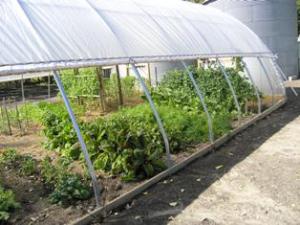NRCS Plants the Seed for High Tunnels
No-till, high tunnel gardening is rewarding and fun, says Victoria Olson, Lakota, N.D.

It is also less work than traditional outside gardening, she says.
With a grant from the USDA Natural Resources Conservation Service in North Dakota, she and her husband, Jim, put up a high tunnel – an unheated greenhouse-like structure that has a clear plastic roof and sidewalls – on their farmstead in 2018. It is 12-feet tall (she can drive a small tractor down the middle of it), 30-feet wide and 72-feet long. The tunnel is covered with 12-ml thick plastic.
Purchased as a kit, the high tunnel was delivered by semi-truck and came in three cardboard crates. Everything was included in the kit except the wood that is recommended at the bottom and ends of the tunnel.
Olson is able to plant seeds in the structure in April and can harvest frost-tolerant crops well into November. She grows many garden fruits and vegetables including potatoes, lettuce, peas, beans, carrots, tomatoes, peppers, sweet corn, cucumbers, muskmelon, tomatillos, okra, swiss chard, jalapenos, acorn squash, onions, beets and radishes.
The tunnel increases air temperatures significantly in warmer months, sometimes by as much as 20-30 degrees F. Olson regulates temperatures by rolling up or down the sides of the tunnel to increase or decrease ventilation and plans to add fans to help circulate the air.
Tunnels tend to hold more humidity which is good for most plants but can cause powdery mildew for others. She closely monitors temperatures and humidity levels with sensors mounted at several elevations inside the tunnel.
“It creates its own little ecosystem,” she says.
The yield and quality of the produce in the high tunnel garden seems to be better than in an outside garden, Olson says. The structure protects the plants from wind and rain damage.
Olson only tilled the soil once before erecting the high tunnel and has since mulched the soil with newspaper and straw.
“In my outdoor garden, I felt I was spending more time weeding than harvesting. Now, I only have to pull a few weeds that come up next to the plants,” she says.
The decomposing mulch is good for the soil and helps to retain moisture after watering, too.
“I have a lot more earthworms and the soil is getting much more loamy,” she says.
The only downside to a high tunnel is that you have to water the garden by hand, Olson says. But she plans to automate watering in the future by placing soaker hoses or drip irrigation lines under the mulch.
Olson produces and preserves enough food that she and her husband eat from the garden year-round. She also shares the produce with family, friends and neighbors.
“When people come to visit, a walk through the hoop house is always one of the first things they want to do,” she says.
The NRCS grant reimbursed her for 100% of the high tunnel kit cost. The grant pays a per square foot amount up to a maximum limit amount. Olson was responsible for covering the wood material cost.
Olson recommends considering a few things before putting up a high tunnel. Location is important, she says. You want your soil to be good before going through the process of erecting the structure. Another factor is how the weather will affect the structure. Wind damage is risk. Finding a protected area that gets full sun would be advantageous for your tunnel and garden.
The staff at her local NRCS field office were easy to work with and helped with filling out the grant application, she says. The soil conservationist also took soil core samples so Olson could submit them to a soil testing company.
NRCS has held a high tunnel tour at Olson’s farmstead.
“Seasonal high tunnels have become a popular option for extending the growing season,” says DeAnn Schneider, district conservation, Lakota Field Office. “It’s great that we have an incentive program to help gardeners try them.”
Statewide, NRCS has provided grants to 76 individuals over the past seven years. Commercial farmers, farmer’s market gardeners and home gardeners are all eligible for the grant.
For more information, contact your local NRCS office.
Media contact:
Lon Tonneson
for the Natural Resources Conservation Service - North Dakota
lon.tonneson@gmail.com
(701) 361-1105

